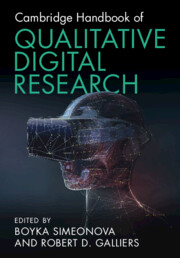Book contents
- Cambridge Handbook of Qualitative Digital Research
- Cambridge Handbook of Qualitative Digital Research
- Copyright page
- Contents
- Figures
- Tables
- Contributors
- Preface
- Part I Philosophical, Epistemological and Theoretical Considerations
- Part II Methodological Considerations
- Chapter 7 Human Values in a Digital-First World: The Implications for Qualitative Research
- Chapter 8 One Picture to Study One Thousand Words
- Chapter 9 Demystifying the Digital
- Chapter 10 Case Study Research Revisited
- Chapter 11 Social Media Qualitative Research Vignettes
- Chapter 12 Co-Inquiring in a Digital Age
- Part III Illustrative Examples and Emergent Issues
- Index
- References
Chapter 11 - Social Media Qualitative Research Vignettes
from Part II - Methodological Considerations
Published online by Cambridge University Press: 08 June 2023
- Cambridge Handbook of Qualitative Digital Research
- Cambridge Handbook of Qualitative Digital Research
- Copyright page
- Contents
- Figures
- Tables
- Contributors
- Preface
- Part I Philosophical, Epistemological and Theoretical Considerations
- Part II Methodological Considerations
- Chapter 7 Human Values in a Digital-First World: The Implications for Qualitative Research
- Chapter 8 One Picture to Study One Thousand Words
- Chapter 9 Demystifying the Digital
- Chapter 10 Case Study Research Revisited
- Chapter 11 Social Media Qualitative Research Vignettes
- Chapter 12 Co-Inquiring in a Digital Age
- Part III Illustrative Examples and Emergent Issues
- Index
- References
Summary
The chapter outlines social media and qualitative research. It describes social media for data collection and different qualitative research approaches to data collection. The chapter describes social media as a phenomenon for research and outlines different levels of social media utilization: individual, work-practice and supra-organizational levels. Vignettes for the different levels are provided and the need for qualitative research concluded.
- Type
- Chapter
- Information
- Cambridge Handbook of Qualitative Digital Research , pp. 160 - 171Publisher: Cambridge University PressPrint publication year: 2023



